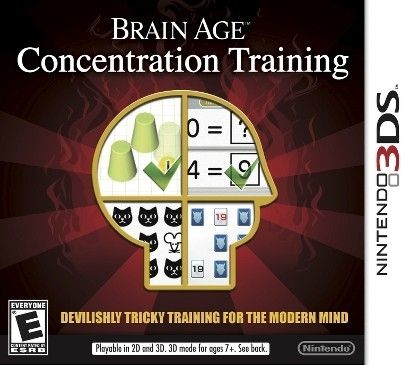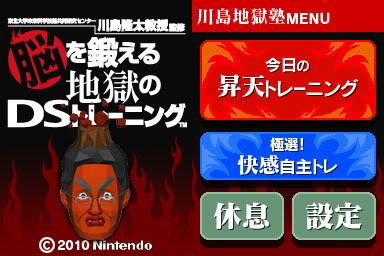
Release Date(s):
JP: July 28, 2012
NA: February 10, 2013 ($29.99 retail/download) (download size - 3359 blocks/~400 MBs)
EU: July 28, 2017
Publisher: Nintendo
Platform: Nintendo 3DS
Genre: Education
Multiplayer: Non-simultaneous. Compare results across multiple players on same game.
What is it? Hard.
No, really. What is it? Very hard.
Brain Age: Concentration Training is the third game in the Brain Age series from Nintendo. Whereas the first two games were focused on speeding up your ability to process information, the third game is focused on expanding your capacity to retain information in short-term "working memory." (Link: "'Working memory' refers to the memory process for temporarily holding, manipulating and using information. It is a brain function that checks goal-oriented memorized material against multiple pieces of stored information and responds appropriately.") In computer terms, the first two Brain Age games were focused on increasing your brain's CPU processing ability and the third game is focused on increasing your brain's RAM. The first game created for this Brain Age is N-back. It was originally requested by Dr. Kawashima to help Japanese Olympic athletes before the 2010 Winter Olympics. According to the Iwata Asks columns on BACT, "those athletes actually surprised everyone by achieving new personal bests." This was on an Olympic event called "Skeleton", which is like a one-person bobsled on a boogie board. A key for this sport is remembering the track and finding your ideal lines down the course. Increasing the brain's RAM, in this case, would then potentially allow them to retain more of their last run in working memory to improve their time on the next run. Nintendo then decided to turn it into a full game on DS, which changed to 3DS.
N-back is a series of simple math problems (i.e. addition and subtraction with total between 0 and 9), but instead of answering the question being shown, you answer the question shown "n" times previously. So in 1-back, if the first equation is "2+3" and the second equation is "4+5," you'd write "5" when the second equation is shown. 1-back isn't hard. Some people have trouble with 2-back. 3-back was the initial wall for me. It's in hitting that wall where your brain is forced to adapt, and BACT keeps you near/at the wall with its dynamic difficulty. If you score "well' on the current level, it gets harder. If you tank, the level goes down. If you do "okay," you stay at the current level. In this manner, BACT keeps challenging you to get better and better. Each session is timed for 5 minutes of work (Dr. Kawashima talking in-between doesn't count against the time). In the next day's session, you start off where you would've been if the previous day's session had continued. Meaning that if you scored 85% or higher on 3-back the previous today (i.e. "well"), you go to 3-back Fast today. That's how BACT keeps you constantly pushing your own limits in its predetermined games. In addition to N-back, there's Word-focused concentration training, keeping track of hidden items behind moving blocks, and others.
In addition to the main Brain Age Concentration exercises, there are also some "Supplemental exercises" (repeats from previous Brain Age games, including Calculations x 20), Relaxation Training, and Awards (amongst some other options). Relaxation Training are puzzle/time-waster type games like Dr. Mario-type and other falling item puzzles. Games you can put your mind into cruise control to play. Awards are like an achievement system for the game to give you a little "good job" boost for reaching a higher level or for training for multiple days. The award is in the form of a certificate from Dr. Kawashima.
There is a demo on the eShop showing N-back training, so give it a shot.
Supplemental Information:
* Iwata Asks: Dr. Kawashima
* Iwata Asks: BACT Developers
Early screenshot for tentatively titled "Dr. Kawashima Hellish Training"
(They really wanted to emphasize that it's hard.


